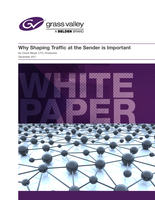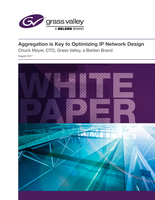WHITEPAPERS
Whitepapers
Why Shaping Traffic at the Sender is Important Whitepaper
—by Chuck Meyer, Chief Technical Officer, Production, (GVB-1-0657B-EN-WP) File size: 1.3 MB, posted Mar 05 2019
To manage this risk in advance, broadcasters should consider how the buffers in the switch work and ensure that data senders behave in such a way that the buffers never become too full. This practice is known as sender traffic shaping. To ensure pre-compensating for this adverse effect is efficiently applied to IP, broadcasters must follow one rule: the network must be designed and managed for the desired traffic load.
Shaping sender traffic is important for system reliability, and it is equally important to consider its impact for low latency and jitter in live production systems. To ensure the optimal workflow and performance, use the proposed SMPTE 2110-21 standard as a way to design the system, and then verify this, as well as system performance requirements, with your router vendor.
To manage this risk in advance, broadcasters should consider how the buffers in the switch work and ensure that data senders behave in such a way that the buffers never become too full. This practice is known as sender traffic shaping. To ensure pre-compensating for this adverse effect is efficiently applied to IP, broadcasters must follow one rule: the network must be designed and managed for the desired traffic load.
Shaping sender traffic is important for system reliability, and it is equally important to consider its impact for low latency and jitter in live production systems. To ensure the optimal workflow and performance, use the proposed SMPTE 2110-21 standard as a way to design the system, and then verify this, as well as system performance requirements, with your router vendor.
Aggregation is Key to Optimizing IP Network Design Whitepaper
—by Chuck Meyer, Chief Technical Officer, (GVB-1-0650C-EN-WP) File size: 1014.3 KB, posted Mar 05 2019
The world of IP technology moves rapidly. The speed with which data moves through an Ethernet connection and the amount of bandwidth that connection can accommodate increases at a rate that makes network planning challenging. What makes it even more challenging? Usually, higher bandwidth interconnects, such as active optical connectors, are initially more expensive and less available due to their rapid adoption by data center and telecommunications installations. Supply eventually catches up to the demand, but costs sometimes make early adoption prohibitive.
In the world of broadcast and media distribution, IP networks are being deployed to exploit the benefits that this technology presents: scalability; simplified geographic distribution; workflow efficiency; and the promise of future bandwidth increases. They are also being deployed in an effort to provide faster adoption of new media distribution services and formats as the role of traditional broadcast evolves into a more consumer choice-driven business model.
The world of IP technology moves rapidly. The speed with which data moves through an Ethernet connection and the amount of bandwidth that connection can accommodate increases at a rate that makes network planning challenging. What makes it even more challenging? Usually, higher bandwidth interconnects, such as active optical connectors, are initially more expensive and less available due to their rapid adoption by data center and telecommunications installations. Supply eventually catches up to the demand, but costs sometimes make early adoption prohibitive.
In the world of broadcast and media distribution, IP networks are being deployed to exploit the benefits that this technology presents: scalability; simplified geographic distribution; workflow efficiency; and the promise of future bandwidth increases. They are also being deployed in an effort to provide faster adoption of new media distribution services and formats as the role of traditional broadcast evolves into a more consumer choice-driven business model.












